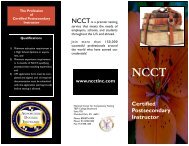P.A.C.E.® Approved COURSE DESCRIPTION - National Center for ...
P.A.C.E.® Approved COURSE DESCRIPTION - National Center for ...
P.A.C.E.® Approved COURSE DESCRIPTION - National Center for ...
You also want an ePaper? Increase the reach of your titles
YUMPU automatically turns print PDFs into web optimized ePapers that Google loves.
19. Desensitization techniques used by psychologists and psychiatrists are a<br />
very successful treatment <strong>for</strong> needle phobic patients.<br />
a. True<br />
b. False<br />
20. Which of the following happens in Step 2 of the desensitization treatment?<br />
a. The anxiety level of individuals at risk is identified.<br />
b. The patient develops a sense of control to minimize his/her anxiety.<br />
c. The patient is gradually exposed to needlestick equipment.<br />
. d. The patient learns to use relaxation techniques.<br />
21. Which of the following is recommended to help prevent the development of<br />
needle phobia?<br />
a. Healthcare providers should ask if the patient has fainted, felt anxious, and/or<br />
is extremely sensitive to pain.<br />
b. Topical anesthetics should be used if the patient is identified as high risk <strong>for</strong><br />
needle phobia.<br />
c. Healthcare providers should treat all individuals who have anxiety and/or fear<br />
with compassion and empathy.<br />
d. All of the above are recommended.<br />
22. Improved care can assist as many as __________ % of needle phobics in dealing<br />
with their anxiety.<br />
a. 10-15<br />
b. 20-40<br />
c. 50-70<br />
d. 90-100<br />
*end of test*<br />
Page 18 of 19



